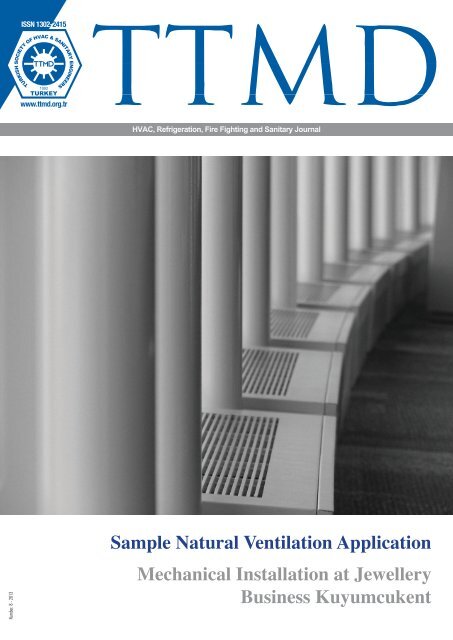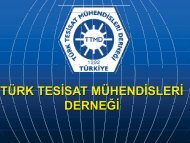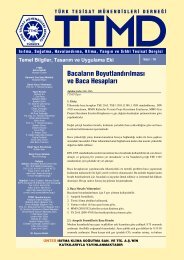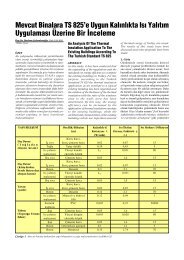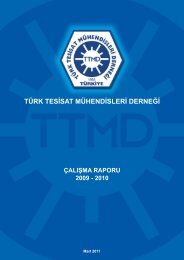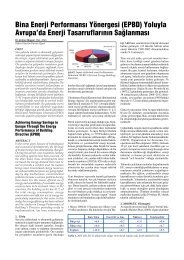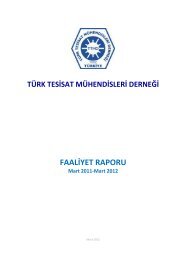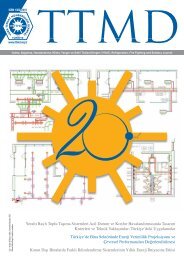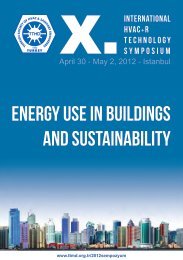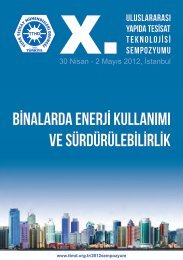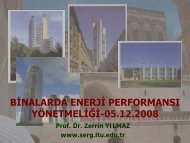Sample Natural Ventilation Application Mechanical ... - TTMD
Sample Natural Ventilation Application Mechanical ... - TTMD
Sample Natural Ventilation Application Mechanical ... - TTMD
- No tags were found...
You also want an ePaper? Increase the reach of your titles
YUMPU automatically turns print PDFs into web optimized ePapers that Google loves.
Number: 8 - 2013<strong>Sample</strong> <strong>Natural</strong> <strong>Ventilation</strong> <strong>Application</strong><strong>Mechanical</strong> Installation at JewelleryBusiness Kuyumcukent
President’s OverviewOwner on Behalf of <strong>TTMD</strong>:Gürkan ArıResponsible for Publication:Murat ÇakanResponsible Editorial Manager:B. Hakkı BuyrukZeki AksuTuba Bingöl AltıokYalım AtalaySuat ArzıkAbdullah BilginŞaban DurmazGöksel DuyumArtuğ FenercioğluDevrim GürselHasan HeperkanKahraman AlbayrakAhmet Arısoyİbrahim AtılganErdinç BozAytekin ÇakırCelalettin Çelikİrfan ÇelimliKevork ÇilingiroğluFatma ÇölaşanNilüfer EğricanHüseyin ErdemSerper GirayGülden GökçenErsin GürdalSerdar GürelMurat GürenliHüseyin GünerhanArif HepbaşlıHasan HeperkanEDITORIAL BOARDADVISORY COMMITTEECONTACT<strong>TTMD</strong> Head OfficeBestekar Sk. Çimen Apt. No:15/2Kavaklıdere/AnkaraTel: 0 312 419 45 71-72Faks: 0 312 419 58 51Web: www.ttmd.org.trE-posta: ttmd@ttmd.org.trEnder İrenAtilla KantarmanEren KalafatOnur KocaCafer ÜnlüGüven ÖğüşNazif ÖzakıncıZüleyha ÖzcanErdal TaştekinBirol YavuzAkdeniz HiçsönmezÖmer KantaroğluEngin KenberAbdurrahman KılıçBirol KılkışOlcay KıncayÖmer KöseliRüknettin KüçükçalıCelal OkutanBaycan SunaçNuman ŞahinMacit ToksoyHaşmet TürkoğluGönül UtkutuğAbdülvahap YiğitTuncay YılmazZerrin YılmazDear colleagues,The concrete impacts of climatic problems triggeredby increased environmental pollution due to intensiveuse of technology and energy in line with modern livingstyle are felt remarkably by modern people. We have todraw necessary lessons from the emerging problemsand their impacts without wasting any further time, andexert efforts to stop this trend and take serious measuresusing our own mind and consciousness. Otherwise, thegrowing imbalance in nature will inevitably cause evengreater problems for mankind.During the last century, mankind headed towards easysolutions in the building sector due to the readily availablecheap energy, exaggerated the artistic dimensions ofthe business, and abandoned the ecological, energyefficientand environment friendly building style. Today,mankind understands that energy resources are notinfinite, and the increased global warming and impactsdue to intensive consumption have directed mankind tonew quests. People of the next century will most probablynot use fossil fuels, even if they are available, and willhave to meet their needs largely from renewable energyresources. In order not to get caught unprepared, we haveto acquire this awareness now and create and introducethe infrastructure for new and renewable technologies.I hope the symposium brings about successful resultsfor our colleagues, industry and country.Gürkan ARIChairman of Executive Board<strong>TTMD</strong>1ProductionASMEDYABirlik Mah. 410. Sok. 5/2 Çankaya / ANKARAwww.asmedya.com.trBaskı/Printing: Dumat Ofset - 2013Distributed throughout Turkey.According to the Turkish Press Laws, the journal is considered to be local periodical.<strong>TTMD</strong> 2013
Turkish Society of HVAC & Sanitary EngineersOur ActivitiesTurkish Society of HVAC and Sanitary Engineers (<strong>TTMD</strong>, TürkTesisat Mühendisleri Derneği) was founded by Mr. Celal OKUTANand his friends in 1992 under the title of , Association of HVAC andSanitary Engineers (“Tesisat Mühendisleri Derneği”) to developHVAC and sanitary engineering, and to earn the sector the respectit deserves. In 1997, the word “Turkish” was added before the titleand a significant step towards becoming a national association wastaken. The Association Economic Enterprise was founded in 2003.<strong>TTMD</strong> regularly holds an “International HVAC+R TechnologySymposium” once every two years, and an annual workshopto discuss a selected topic in detail, participates in domesticand overseas fairs and symposia in the sector, and publicizesand supports such activities. <strong>TTMD</strong> also publishes books forprofessional development, and a bimonthly journal addressing thesector with the title “<strong>TTMD</strong> Dergisi” (previously <strong>TTMD</strong> Bülteni for35 issues). In addition, an English issue is published annually topromote our sector overseas.On the other hand, training programs and seminars are held by ourRegional Offices to improve the service quality of our colleagues. Oursociety tries to facilitate forming of bonds among our colleagues bybringing them together in various platforms, in addition to makinga significant contribution to the sector by improving the quality ofon-the-job training, which is among its purposes of foundation.<strong>TTMD</strong> has become a member of ASHRAE (American Society ofHeating and Refrigeration Engineers) in 1997, of REHVA (Federationof European Heating and Air Conditioning Association) in 2000,and of CLIMAMED (Joint Organization of HVAC&R Associations ofFrance, Italy, Portugal, Spain) in 2009.<strong>TTMD</strong> develops and supports R&D projects within the framework ofuniversity-industry cooperation, takes active part in the preparationof standards and regulations, cooperates with public bodies in thepreparation of regulations thus contributing to their conformitywith the norms, develops and operates national and internationalprojects (EU, FCO, etc.), and continues its publishing andeducational activities in the sector.<strong>TTMD</strong> performs various activities related to installation in line withits charter, and thus contributes to the public good. Some of theactivities of the society performed with this aim are as follows.Realizing knowledge and technology transfer,Contributing to the efficient use of energy in our country, Improvingknowledge accumulation and knowledge sharing in the sector andthus contributing to the building of better buildings and plants,Promoting our Country overseas in its own sector,Representing our colleagues in international platforms andfollowing the developments closely,Contributing to the training and research of our colleagues offeringprofessional services, newly graduated engineers, and studentswilling to develop their skills in this profession in application field,and contribute to knowledge and technology transfer,Providing the necessary communication and discussionenviromnent, Contributing to the research undertaken inuniversities and research centers concerning our profession andimproving the university-industry cooperation,Publication of journals, books, and manuals containing correctand contemporary information on the installation sector, and theestablishment of “Rules of Conduct”,Contributing to the development of the country as we do ourprofession,Creating healthy, safe, hygienic, comfortable, in a word, livableenvironments in different buildings in which people spend about80-90 % of their times,Generating energy-efficient and environment-friendly solutions andcooperating on this issue,Working in coordination with other professional and expertisegroups.<strong>TTMD</strong> Management BoardHistory of PresidencyGürkan ArıPresidentM. Bülent Özgür Vice PresidentBaycan SunaçVice PresidentHırant KalataşVice PresidentBünyamin ÜnlüGeneral SecretaryMurat GürenliTreasurerAbdurrahman Kılıç MemberÖmer KöseliMemberGüniz GacanerMemberKemal Gani Bayraktar MemberTuba Bingöl AltıokMemberSarven Çilingiroğlu MemberRamazan YazganMemberFounding Honorary PresidentCelal Okutan1 st Term - Celal Okutan2 nd Term - Numan Şahin3 rd Term - M. Serdar Gürel4 th Term - Ömer Kantaroğlu5 th Term - Engin Kenber6 th Term - B. Erdinç Boz7 th Term - Hüseyin Erdem8 th Term - Abdullah Bilgin9 th Term - Cafer Ünlü2RepresentationMetin KarabacakAdanaZüleyha ÖzcanAnkaraAyşen Hamacıoğlu Antalyaİbrahim AkdemirBursaTefik DemirçalıDenizliÖzcan TürkbayEskişehirGöksel Duyumİstanbulİbrahim Üstün Tatlıdil İzmirNecdet AltuntopKayseriİlhan Tekin ÖztürkKocaeliÖner BoysalKonyaOrhan CazgırSamsunMustafa Eyriboyun ZonguldakInternational MembershipsAmerican Society of Heating,Refrigerating and Air-Conditioning EngineersFederation of European HVAC AssociationsClimamed<strong>TTMD</strong> 2013
Contents3 President’s Overview6 NEWS6 English Program Symposium 201214 <strong>TTMD</strong> 20 Years of Age15 <strong>TTMD</strong> Projects:Green Careers16 Full Support to the Private Sector inTransition to Low-Carbon Economics:Climate Platform416 The Concept of SustainableConsumption and Production (SCP)and the Project of SCP Turkey16 HIP Work Continues under HIP Project<strong>TTMD</strong> 2013
Contents17 Aqua ConserverFirst Step Taken in Aqua ConserverProject17 <strong>TTMD</strong> in Climamed Congress 201118 <strong>TTMD</strong> In ICHVAC-321 ARTICLE21 <strong>Sample</strong> <strong>Natural</strong> <strong>Ventilation</strong> <strong>Application</strong>Sarven Çilingiroğlu533 <strong>Mechanical</strong> Installation At JewelleryBusinesses KuyumcukentKani Korkmaz<strong>TTMD</strong> 2013
NewsEnglish Program Symposium 20126<strong>TTMD</strong> 2013
NewsHALL AApril 30, 2012 - Monday08:30 - 09:45 REGISTRATION09:45 - 10:45 OPENING CEREMONY10:45 - 11:00 Coffee Break“Looking at İstanbul or Seeing İstanbul!”11:00 - 11:45Opening Conference: Sunay AkınChairman: Numan Şahin11:45 - 12:30HALL B“Future Energy Concepts For Buildings and Districts - From Energy To Exergy”Invited Speaker: Gerhard Hausladen12:30 - 14:00 Lunch14:00 - 15:4014:00 - 14:2014:20 - 14:4014:40 - 15:0015:00 - 15:20Session - 1A - 1: Technical Session: EnergyEfficient BuildingsChairman: Engin KenberImportance of Dynamic Energy Modelling InEnergy Efficient and Green Structure DesignA. Zerrin Yılmaz, Ece Kalaycıoğlu, AlpayAkgüç, Meltem BayraktarEvaluation of Environmental Performances andEnergy Efficiency Projections In The ConstructionIndustry In TurkeyTaner Soner, M. Ziya SögütGreen Buildings: Barriers, Opportunities,Supporting Policies and Creating Demand InThe Transformation Process of The ConstructionIndustryÇağla Pınar Utkutuğ, Gönül UtkutuğPotential Customer Approach to GreenHousings: A Survey in Ankara ÇayyoluÇağla Pınar Utkutuğ, Sanem Alkibay,Zeliha EserSession -1B - 1: Technical Session: EnergyEfficient BuildingsChairman: Erdinç BozEnergy Efficient Double Shell Curtain WallSystems Gözde ÇakırHVAC <strong>Application</strong>s In Elliptical ArchitecturalStructuresCoşku Cengiz, Şenol KılıçPlumbing Systems In Light Steel FrameConstructionsSemih Göksel YıldırımBuilding Material Use In Energy EfficientStructuresÇiğdem Tekin15:20 - 15:40Master Project Integral Design For Net ZeroEnergy BuildingsWim ZeilerEnergy Labelling and Certification In HVACProductsYüksel Köksal15:40 - 16:00 Coffee BreakPANEL: Sustainable Energy Management in Urban TransformationsModerator: Handan Türkoğlu, ITU City and Regional PlanningGerhard Hausladen, The Technische Universität München, Building and Climatization ServicesGençay Tatlıdamak, Architect - Advisor, Sustainable Buildings Designer, IB HausladenEmre Kahraman, City Planner, Municipality of Gaziantep, Department of Housing and Urban16:00 - 18:30 DevelopmentSeda Müftüoğlu, Architect, Municipality of Gaziantep, Department of Housing and UrbanDevelopmentUygur Kınay, Ministry of Environment and Urbanism, General Directorate of Professional Services,Department of Energy EfficiencyAynur Şule Sümer, Municipality of Kadıköy, Head, Department of Environmental Protection andControl18:30 - 20:00 OPENING COCKTAIL - Wow Hotel & Convention Center7In Hall A, there will be simultaneous translation from Turkish to English and English to Turkish.<strong>TTMD</strong> 2013
News09:00 - 10:40May 1, 2012 - TuesdayHALL AHALL BSession-2A-1: Technical Session: Energy Session-2B-1: Technical Session: EnergyEfficient BuildingsEfficient BuildingsChairman: Nilüfer EğricanChairman: Serdar Gürel09:00 - 09:20From Passive House Through nZEB To Energy PlusBuildings, Some Dutch ExamplesWim ZeilerEnergy Use During The Lifespan of A WoodenFrame BuildingHüseyin Günerhan, Burak Hozatlı09:20 - 09:4009:20 - 09:4009:40 - 10:0010:00 - 10:20Active Roof Cooling By Floating WaterWim Zeiler, Derek VissersYour Green Compass: “Environmental Indicators”M. Selçuk ErcanSustainability = MEPS + Assuring ComplianceThrough Third Party CertificationJames WaltersIs The UK’s Zero Carbon Standard For Housing aSolution For CO2 Reduction In Turkey?Passivhaus Standard as a Means to AchievingZero Carbon In IstanbulTuğba Salman Gürcan, Sofie Pelsmakers10:20 - 10:40 Coffee Break10:55 - 12:40Session-2A-2: Technical Session: HVACSystems and EquipmentChairman: Cafer ÜnlüHVAC <strong>Application</strong> In Industrial Buildingsİbrahim Karakaş, Zozan TürkgençEnergy Management and Analysis of EnergySaving Potentials On SiteM. Ziya Söğüt, İnanç Cahit Güremen, HakanKabalarIntegrated Project Management In <strong>Mechanical</strong>Pipework <strong>Application</strong>sHasan Acül10:55 - 11:4011:40 - 12:0012:00 - 12:2012:20 - 12:40“Energy Efficiency of Air Conditioning And <strong>Ventilation</strong> Systems”Invited Speaker: Olli SeppanenPhysical Modeling of Concrete-Core-RadiantCooling System For Upper-Egypt ClimatesAhmed A. Medhat A. FahimMircomachined Metal Oxide Semiconductor GasSensor Modules Used For Comfortable,Energy-Efficient Demand-Controlled <strong>Ventilation</strong>and Building MonitoringSimone Herberger, Heiko UlmerSynchronicity Factor In Air Conditioning ofMulti - Storey CarparksAbdurrahman Kılıç12:40 - 14:00 Lunch8In Hall A, there will be simultaneous translation from Turkish to English and English to Turkish.<strong>TTMD</strong> 2013
News14:00 - 16:0014:00 - 14:2014:20 - 14:4014:40 - 15:00Session-2A-3: Technical Session: HVACSystems and EquipmentChairman: Ahmed A. Medhat A. FahimCertification and Inspection of Building MaterialsRepublic of Turkey Ministry of EnvironmentandUrbanism, General Directorate of ProfessionalServices, Department of Building MaterialsCalculation of Temperature Difference (CLTD)Values In The Cooling Load Being Used For HeatGain Through Building WallsRecep Yumrutaş, Hasan Oktay, Omar ZainalChilled Ceiling <strong>Application</strong> In An OfficeBuilding of A Global CompanyOsman ArıSession-2B-2: Technical Session: HVACSystems and EquipmentChairman: Ömer KantaroğluEffect of Non-Domestic Pipework Systems WithDifferent Efficiencies On Water ConsumptionLevelsÖmer Kantaroğlu, Fikret KantaroğluEnvironmental Evaluation of Central and PackageWaste Water Treatment Plants In Suburban AreasLevent Alatlı, Ergin Erol,Salih Aliipek,Ercan Özdemir, Burcu Elif Vardar,Levent ÇelikkoConcerns In Water Supply Lines In Multi-StoreyBuildingsArcan Hacıraifoğlu15:00 - 15:2015:20 - 15:4015:40 - 16:00Adaptive Control Algorithm of Heating System ForLars Low Energy System Radoslaw Gorzenski,Andrzej Gorka, Edward SzczechowiakEnergy Evaluation and Comparison Between DifferentHVAC SystemsAhmet ArısoyNew Algorithms For Energy EfficiencyIn HVAC SystemsMichele Albieri, Alessandro Beghi,Luca Cecchinato, Mirco Rampazzo16:00 - 16:20 Coffee Break16:20 - 18:0016:20 - 16:4016:40 - 17:0017:00 - 17:2017:20 - 17:4017:40 - 18:00Session-2A-4:Technical Session: HVAC Systemsand EquipmentChairman: Tuncay YılmazEnergy Conservation In BuildingsFiras AldroubiPerformance Analysis of Steam Compression andAdaptive Water Cooling SystemsBülent Orhan, Ali GüngörEnergy Savings Through PIBCV Technology For AirHandling Systems - Case StudyTamas SzekelySteam Compression and AdaptiveTwo-Stage Cooling CycleCanan Cimşit, İlhan Tekin ÖztürkEffect of Control Systems In A Water Cooling SystemOn Energy EfficiencyBekir Cansevdi, Uğur Caner, Ali GüngörRemote Commissioning With “Addressable”Combined Dynamic Balance Valves and SingleStation Balancing (TIB) MethodArcan HacıraifoğluEvaluation of Theoretical and Measured Data FromThe Pumps Being Used In Buildings’ Heating andCooling SystemsOkan Kon, Bedri YükselImprovement In Energy and Water ConsumptionLevels of Buildings During Operation:A Case StudyZ. Cihan Akbulut, Ertuğrul Örs,Celalettin BozdoğanSession-2B-3: Technical Session: RenewableEnergy and <strong>Application</strong>sChairman: Halime PaksoyFloor Level Heat Regenerator Design For Structural<strong>Application</strong>s With Photovoltaic SystemsAhmet Yıldız, Önder Özgener, Leyla ÖzgenerWind Power <strong>Application</strong>s In The BuildingsÖzgün KorukçuOur Country’s Position In Energy ProductionFrom Wave EnergyEmin Akyüz, M.Ziya Yakut, Reşat Selbaş,Arzu Şencan Şahin, İhsan DostuçokEvaluation of Fresnel Reflector and Collector<strong>Application</strong> In Ispartaİhsan Dostuçok, Reşat Selbaş,Arzu Şencan Şahin, Ahmet Özdemir, FatihYılmazEnergy Analysis of Air Heating Sunlight CollectorsWith Internal Perforated BarriersHakan F. Öztop, Fatih Bayrak9In Hall A, there will be simultaneous translation from Turkish to English and English to Turkish.<strong>TTMD</strong> 2013
News09:00 - 10:4009:00 - 09:2009:20 - 09:4009:40 - 10:0010:00 - 10:20May 2, 2012 - WednesdayHALL ASession-3A-1: Technical Session:Indoor Air Quality and Comfort ConditionChairman: Ali GüngörThe User In The Loop For Optimal IndividualComfort and Reduced Energy ConsumptionWim Zeiler, Derek Vissers, Rik Maaijen,Gert BoxemNumerical Analysis of Comfort Conditions In AnOffice With Under Floor HeatingÖzgün Korukçu, Muhsin Kılıç, Jianhua FanAnalysis of Comfort Conditions In A DecisiveEvaporative Air Conditioning Systemİrfan Uçkan, Tuncay Yılmaz, OrhanBüyükalaca, Ertaç HürdoğanEffects of Decorational Plants On Indoor AirQualityHakan Şevik, İdil KanterHALL BSession-3B-1: Technical Session:HVAC Systems and EquipmentChairman: Abdullah BilginWhat is New In DIN 1946-4 2008 Standarts?Can İşbilen, Ummuhan Gencer, Lale UlutepeHot Oil SystemsVeli DoğanWrong Facts In Relation To Seismic Protectionand Vibration Insulation In PipelinesEren KalafatEffects of New EuP Regulations On TurkishSanitary IndustryÇağlar Şakaklı, Derya Çuha10:20 - 10:4010:40 - 10:55 Coffee Break10:55 - 12:4010:55 - 11:4011:40 - 12:0012:00 - 12:2012:20 - 12:40Session-3A-2: Technical Session: RenewableEnergy and <strong>Application</strong>sChairman: Hüseyin ErdemThermodynamic Analysis of A Power Cycle UsingAbove-CriticalCarbondioxide Under Water Heater EffectAtilla Bıyıkoğlu, Reşit Yalçınkaya“Holistic Approach To Energy Efficient Green Buildings”Invited Speaker: Essam E. KhalilDeveloping A Renewable Energy Selection ToolkitFor Istanbul ‘’The Istanbul Renewable Toolkit’’Tuğba Salman Gürcan, Sofie PelmakersSustainable Energy Use In The Building By AquiferThermal Energy StorageHalime Paksoy, Bekir Turgut12:40 - 14:00 LunchINTEGRATED DESIGN IN BUILDING WORKS-HOPDIFFERENT DISCIPLINES’ OVERVIEW OFINTEGRATED DESIGNAdministrator: A. Zerrin Yılmaz, SüleymanAkım,Göksel DuyumSpeakers: A. Zerrin Yılmaz (BinSimDer-IBPSA),Ayşe Hasol(TSMD), Abdullah Bilgin (<strong>TTMD</strong>), Berrin Yavuz(ETMD), Ömer Yalçın (Carrier System Design10In Hall A, there will be simultaneous translation from Turkish to English and English to Turkish.<strong>TTMD</strong> 2013
News14:00 - 16:0014:00 - 14:2014:20 - 14:4014:40 - 15:0015:00 - 15:2015:20 - 15:4015:20 - 15:40Session-3A-3: Technical Session:Modelling and SoftwaresChairman: Bülent YeşilataNumerical Modeling of Air Flow Regimes InsideBuilding Light ShaftsAhmed A. Medhat A. FahimNumerical Investigations of Flow Patterns andThermal Comfort In Air-Conditioned Lecture RoomTaher M. Abou-Deif, Mahmoud A. Fouad,Essam E. KhalilDeveloping a Web Based Software For TheCalculation of Cooling Load For The Buildings InTurkeyAzmi Aktacir, M. Akif Nacar, Bülent Yeşilata,M. Emin Tenekeci, Burak Yenigün, Emrah YakaAdiabatic Humidification and Cooling As AnAlternativeAxel ZedinaDetermining Conduction Time Series (CTSCoefficients By An Analytical Approach For TheCalculation of The Looling Load For The BuildingsBurak Yenigün, Azmi Aktacir, Bülent Yeşilata,Emrah YakaAdiabatic Humidification and Cooling As AnAlternativeAxel ZedinaINTEGRATED DESIGN IN BUILDINGWORKSHOP14:00 - 14:50INTEGRATED DESIGN AND PROBLEMS OFDESIGNERS15:10 – 16:00SUGGESTIONS AND GOALS15:40 - 16:00 Coffee Break16:00 - 18:30Forum: Future of HVAC Systems?“Aqueous Systems, Full - Air Systems and DX Systems”Director: Ahmet Arısoy(Only registrated participants can attend to the Forum)20:00CLOSING DINNER- Kör Agop Restaurant, KumkapıPlease ask Registration Desk For Tickets.In Hall A, there will be simultaneous translation from Turkish to English and English to Turkish.11<strong>TTMD</strong> 2013
SPONSORSHIP ASPONSORSHIP BWe are expressing our sincere gratitude for your valuable contribution.
News<strong>TTMD</strong>20 Years Of Age14Turkish Society of HVAC and Sanitary Engineers wasfounded by Mr. Celal OKUTAN and his friends in 1992under the title of Associations of HVAC and SanitaryEngineers to develop HVAC and Sanitary engineering,and to earn the sector the respect it deserves. In1997, the word “Turkish” was added to the title anda significant step towards becoming a nationalassociation was taken. The Association EconomicEnterprise was founded in 2003.<strong>TTMD</strong> regulary holds an “International HVAC+RTechnology Symposium” once every two years, andan annual workshop do discuss a selected topicin detail, praticipates in national and internationalfairs and symposia in the sector, and publicizies andsupports such activities. <strong>TTMD</strong> also publishes boksfor proffesional development, and a bimonthly journaladdressing the sector with the title “<strong>TTMD</strong> Journal”(previously <strong>TTMD</strong> Bülteni for 35 issues). In addition,an English issue is published annually to promote oursector in an international level.On the other hand, training programs and seminarsare held by our Regional Offices to improve the servicequality of our colleagues. Our society tries to faciliateforming of bonds among our colleagues by bringingthem together in various platforms, in addition tomaking a significant contribution to the sector byimproving the quality of on-the-job training, which isamong its purposes of foundation.<strong>TTMD</strong> develops and supports R&D projects withinthe framework of university-industry cooperation,takes active part in the preparation of standartsand regulations, cooperates with public bodies inthe preperation of regulations thus contributingto their conformity with the norms, develops andoperates national and international projects (fundedby EU, FCO,etc.), and continues its publishing andeducational activities in the sector.<strong>TTMD</strong> has become a member of ASHRAE (AmericanSociety of Heating, Refrigerating and Air-ConditioningEngineers) in 1997, of REHVA (Federation of EuropeanHeating and Air Conditioning Associations) in 2000,and of CLIMAMED (Joint Organization of HVAC&RAssociations of France, Italy,Portugal, Spain) in 2009.The objectives of <strong>TTMD</strong> include; first and foremost,contributing to the training and research of ourproffesional colleagues, fresh graduates, and studentswilling to develop their skills in this professionin application field; contributing the knowledgeand technology transfer; providing the necessarycommunication and discussion opportunities;contributing to the research undertaken in universitiesand research centers concerning our sector; andimproving the university-industry cooperation.Publication of “Manuals” containing correct andcontemporary information on the installation sector,and the establishment of “Rules of Conduct” arealso among our main objectives. Keeping theseup-to-date is the responsibility of our dynamic andconcerned Committees and Commissions alwaysin operation. Contributing to the development of ourcountry as we do our proffesion, and in this contextcreating healthy, safe, hygienic, comfortable, in a word,livable environments in different buildings in whichpeople spend about 80-90% of thier times; generatingenergy-efficient and environment-friendly solutionsusing the opportunities offered by the nature; workingin coordination with other professional and expertisegroups.<strong>TTMD</strong> 2013
News<strong>TTMD</strong> Projects:Green Jobs<strong>TTMD</strong>’s Project “Training Youthfor Green Jobs” CompletedThe “Project for Training and Ensuring the Employabilityof Youth on Energy Efficiency in Buildings” (TrainingYouth for Green Jobs) executed by Turkish Society ofHVAC and Sanitary Engineers between 01 December2010 and 30 November 2011 under the EuropeanUnion’s “Youth Employment Promotion” GrantProgram has been successfully completed.Under the project executed concurrently in Erzurum,Kayseri and Samsun, very intensive project activitiesincluding “Project Evaluation Meetings”, “PressConferences”, “Receipt and Evaluation of Trainee<strong>Application</strong>s”, “Implementation of Theoretical andApplied Training Programs”, “Energy EfficiencyInformation Days” have been carried out as from 10December 2010. The project activities continued with“Energy Efficiency Awareness Week”, “Matching”and “Certificate Award Ceremony” in the second,third and fourth weeks, and finally the project wasconcluded with evaluation and closing meetings heldin Ankara with the participation of Project Partnersand Participants.<strong>Application</strong>s from the graduates of undergraduateprograms, vocational higher schools and vocationalsecondary schools who have not been employed yet orwho have been employed but are not working currentlyhave been accepted for the training programsorganized under the project on a priority basis. A totalof 156 trainees, 52 from each province, participated inthe training programs, which covered such subjectsas heat insulation, heating and cooling systems, HVACsystems, lighting systems, electrical equipment, solarpower, etc. The training programs provided mostcurrent theoretical and applied technical informationfort he efficient use of energy. The programs particularlycovered the relevant legislation, labor safety,entrepreneurship and business plan preparation forthe trainees who want to start their own businesses.Besides the training programs, seminars andinformation meetings were organized as part ofthe activities intended to raise the level of publicawareness and knowledge about energy efficiency inthe provinces covered by the project. Furthermore,visually designed stands were established in citycenters, and brochures and promotional materialswere distributed to local people. The trainees andother specialists took part in the stands and answeredthe questions of people and thus contributed to raisingthe level of public awareness.The project was implemented in full coherence with theproject partners including Erzurum Kazım KarabekirTechnical and Industrial Vocational SecondarySchool, Kayseri Mimar Sinan Technical and IndustrialVocational Secondary School and Samsun AtakumTechnical and Industrial Vocational Secondary Schoolas well as the officials and specialists from the projectparticipants who took active part in the theoretical andapplied training sessions, including İzocam Ticaret veSanayi A.Ş., Testo Elektronik ve Test Ölçüm CihazlarıDış Tic. Ltd. Şti. and Vaillant Isı Sanayi Ticaret Ltd. Şti.152 out of 156 trainees (97.4%) who received 132 hoursof theoretical and 192 hours of applied training in theirrespective fields of specialization succeeded in theexams held at the end of training and received theircertificates in a ceremony. The successful traineeswere introduced to the employers active in this sectorthrough a matching activity, in order to contribute totheir employment. 36 trainees certificated followingthe completion of theoretical and applied trainingprograms were placed to jobs.A web page was created to introduce all activitiescarried out under the project and the trainees whoparticipated in the training programs.(http://www.proje.ttmd.org.tr).15<strong>TTMD</strong> 2013
NewsFull Support to the Private Sector in Transition toLow-Carbon Economics: Climate PlatformWith the Climate Platform to be founded as part ofthe “Development of Climate Change Initiative in theTurkish Business World” project with the cooperationof the Turkish Society of HVAC and Sanitary Engineers(<strong>TTMD</strong>) and the Regional Environmental Center(REC), creation of a sustainable platform to improvethe lobbying and participation abilities of the TurkishBusiness World in national and international levelsis aimed, as well as translation to Turkish of aninternational training program to develop the capacityof Turkish firms in the field of calculating greenhousegas emissions. Detailed information about the ClimatePlatform can be found at www.iklimplatformu.orgThe Concept of Sustainable Consumption andProduction (SCP) and the Project of SCP TurkeyThe project team which includes, among others, theTurkish Society of HVAC and Sanitary Engineering(<strong>TTMD</strong>) and the Technology Development Foundationof Turkey (TTGV), which is one of the 4 national contactpoints designated as part of the “Partnering to EnhanceCivil Society Organizations’ Contribution to Researchin Sustainable Consumption & Production” project,which is supported by the 7th Framework Programand run under the short title of CSOContribution2SCP(Action Town), aims run a pilot project to publicize theconcept of SCP in Turkey, increase consciousness, andimprove the relations between the partners. Detailedinformation can be found at www.scp-centre.org16HIP Work Continues underHIP ProjectOne year has passed in the HIP Project, which is beingexecuted by 11 Institutes and SMEs from 6 countries(UK, Ireland, Spain, Norway, Turkey), including TurkishSociety of HVAC and Sanitary Engineers. Under theproject originally named “Project for developmentof low-cost, lightweight highly insulating polymersfor refrigerated transport, heating and coolinginstallations”, project progress is being supervisedthrough quarterly meetings. Under the project whichwill develop a new class of high internal/natural-phaseemulsion-based polymer insulation material, althoughsome materials have been used in many applications,materials that have never been used in circumstancesrequiring high performance will also be used. In suchmaterials, it is possible to easily control porosity, poresizes, distribution and mechanical features. For thesereasons, calorific characteristics of the material canbe secured low-cost production processes. Withinthe framework of the project to last 3 years, SMEs arecoming together under the sub-heading of PartnershipResearch Projects for SMEs under the 7th FrameworkProgram, and executing the project with a budgetof Euro 2.6 million. The next meeting under theproject will be held in London and will be hosted byTICA (Thermal Insulation Contractors Association).Detailed information about Project HIP is available atwww.fp7-hip.eu.<strong>TTMD</strong> 2013
NewsAqua ConserverFirst Step Taken in Aqua Conserver Projectwater treatment and heat recovery system that canbe commissioned following minor modifications, asmay requested by the citizens in the EU member andcandidate states, building on the concepts of energyand water economy.Turkish Society of HVAC and Sanitary Engineers istaking part in one more international project, followingthe project “Training Youth for Green Jobs” which wascompleted in 2011. The project inception meetingtitled “A novel and combined domestic grey watertreatment and heat recovery system suitable for costeffective installation in 90% of European households:AQUACONSERVER” was held in Istanbul on 05January 2012 and was hosted by <strong>TTMD</strong>. The projectis supported under the 7th Framework Program ofthe EU and includes <strong>TTMD</strong> as a member of projectconsortium.”The Project being executed by the UK Health andEnvironment Research Institute (HERI) aims atintroducing, by mid-2014, a low-cost domestic greyTwelve institutes, SMEs and NGOs including <strong>TTMD</strong>(the UK Health and Environmental ResearchInstitute-HERI, The Environmental And SustainableConstruction Association-EASCA, IGP srl, Logrotex SA,Convex Electrical Ltd, Haswell Moulding TechnologiesLtd, Aqualisa Products Ltd, Tecniberia, AsociacionEspanola De Empresas De Ingenieria, Consultoria YServicios Tecnologicos-TECNIBERIA, Novamina CentarInovativnih Tehnologija Doo-NOVAMINA, InstitutoDe Biologia Experimental E Tecnologica-IBET, PolskaKorporacja Techniki Sanitarnej, Grzewczej, Gazoweji IKlimatyzacji-PKTSGGK), from 8 countries (Croatia, UK,Ireland, Spain, Italy, Poland, Portugal and Turkey) havecome together for this project with a budget of Euro 1.9million, which was accepted under the “Partnership/Cooperation Projects for SMEs” component of the 7thFramework Program that will last 3 years. Detailedinformation about AquaConserver Project is availableat http://www.aquaconserver.eu/.<strong>TTMD</strong> in Climamed Congress 2011The congress took place in Casa de América, one of themost prominent examples of Madrid’s architecturalheritage, under the auspices of Spanish TechnicalAssociation of Air Conditioning and Refrigeration(ATECYR) with the participation of many engineers andacademicians from Spain, Italy, France and Turkey.Turkish HVAC and Sanitary Engineers Society PresidentGürkan Arı participated the opening speech on the firstday together with French HVAC and Sanitary EngineersSociety (AICVF) President Bertrand Montmoreau,Italian HVAC and Sanitary Engineers Society (AICARR)President Renato Lazzarin, Spanish TechnicalAssociation of Air Conditioning and Refrigeration(ATECYR) President Juan Jose Quixano, Spanish EnergyConservation and Energy Diversity Institute (IDAE)17<strong>TTMD</strong> 2013
NewsPresident Alfonso Beltran and Climamed 2011 PresidentJulio Cano Lacunza. Gürkan Arı informed about Turkishmechanical and HVAC sector and building energyperformance strategies in Turkey.39 technical papers were presented on the topics suchas energy efficiency, renewable energy sources, indoorair quality, energy performance assessment, etc. 10 ofthese papers were presented by Turkish experts.Turkey participated the Congress actively with nearly40 participants and as a country with a high levelof participation had the second highest number ofpaper submissions after host country Spain. The nextCLIMAMED Congress will be held in Turkey in 2013 tobe hosted by <strong>TTMD</strong>.18<strong>TTMD</strong> in ICHVAC-3With the collaboration of United Nations EnvironmentProgramme (UNEP) and Turkish Society of HVAC andSanitary Engineers (<strong>TTMD</strong>), the Third InternationalConference on Heating Ventilating and Air Conditioning(ICHVAC-3)” was being held in Tehran, the capital ofIran, on 24-26 May 2011. <strong>TTMD</strong> President Gürkan Arı andBoard Member Dr. Kemal Gani Bayraktar participatedthe conference on behalf of our organization. GürkanArı introduced <strong>TTMD</strong> and its activities and sharedinformation about HVAC Sector in Turkey at his openingspeech. Moreover, he summarized that how energyefficiency and new regulations affect the developmentof the sector by presenting data with examples.<strong>TTMD</strong> Committee made contacts with Iran within thescope of the conference, got together with Director ofSchool of <strong>Mechanical</strong> Engineering Sharif University<strong>TTMD</strong> 2013
Newsof Technology, Prof. Dr. Mohammad H. Saidi and gotinformed about 6 departments in the school whilevisiting research laboratories.Different departments such as Biomechanics, OceanEngineering, Manufacturing and Production, EnergyTransformation, Applied Mechanics, Mechatronicwere examined and potential collaborations werestudied within the scope of the visit. The school has40 different laboratories. Out of 1200 students, thereare 112 Phd students and 400 MSc students in theschool. The school has built strong connectionswith the industry and 14 out of 43 personnel workin department of Energy Transformation. Later in ameeting with Energy Engineering School Director Prof.Dr. Moustafa Sohrabpour and his team, informationabout master’s and doctorate programs for SystemEngineer, Environmental Engineers, Energy Engineersand Nuclear Engineers was presented. The institutionsgot to know each other and potential collaborationswere discussed.Same day in the afternoon Sharif Energy Institute underthe direction of Prof. Dr. Yadollah Saboohi was visited.The institute works especially on commercializingnew technologies and offers master’s and doctorateprograms. The institute who works in cooperationwith public institutions and with the industry focusingon R&D, was introduced in a working meeting andpotential collaborations were discussed.14 workshops were held as well as many technicalsessions at the conference. Main conference topicswere as follows:At the opening of the conference and the exhibitionwhere <strong>TTMD</strong> took part with a stand as well, TurkishHVAC+R market was introduced with catalogsand pamphlets that were handed out. Same day inthe afternoon a workshop called Energy EfficiencyPractices in Turkey was conducted and 3 presentationswere given to the conference participants by <strong>TTMD</strong>committee. “Cogeneration and its <strong>Application</strong>s” byMr. Özay Kas, “Shopping Mall <strong>Application</strong> Model forHeat Pump” and “Energy Efficiency in Buildings andPassive Approaches” by Dr. Kemal Gani Bayraktarwere presented at the workshop. Our stand in theexhibition hall was visited by our commercial attachéMr. Alper Çakıroğlu as well. 84 papers out of 148 hadbeen presented verbally and in written form at theconference which took 3 days with participants morethan 450.1. New design criteria in HVAC&R2. National codes and standards in HVAC&R3. Industrial HVAC&R systems4. New emerging technologies in HVAC&R systems5. Indoor air quality and comfort conditions6. Environmentally friendly air-conditioning, coolingand refrigeration techniques7. Energy optimization<strong>TTMD</strong> committee got together with miscellaneousNGO representatives in the evening of the first day ofthe conference and evaluated sustainable potential forcollaboration in many aspects while indicating the firstpossible steps.19<strong>TTMD</strong> 2013
Article<strong>Sample</strong> <strong>Natural</strong> <strong>Ventilation</strong><strong>Application</strong>Sarven ÇilingiroğluSection 1. Development Of Design Strategy:1. Meeting The System Requirements:Two key factors affecting environmental performanceare taken into consideration in the design of <strong>Natural</strong><strong>Ventilation</strong> System.- <strong>Ventilation</strong> to maintain indoor air quality at thesufficient level- <strong>Ventilation</strong> in addition to other systems reducesthe overheating tendency of buildings particularlyduring summer months.<strong>Natural</strong> ventilation strategy must be taken intoconsideration while designing other systems as well.While designing buildings, natural ventilation must betaken into account. Factors to consider are;- Sufficient acoustic environment: <strong>Natural</strong>ventilation openings increase sound transmissioninto indoor spaces from the exterior. Depending onthe position of the building, this may be a determiningfactor. Furthermore, naturally ventilated buildingsinvolve excessive exposed concrete to enhance thethermal capacity of the space. Such large areas mustbe carefully designed to secure appropriate acousticenvironment.- Smoke Control: Because smoke may follownatural ventilation tracts, fire safety system must beable to operate in an integrated manner with naturalventilation system.- Health and Safety: Most natural ventilationopenings will be positioned much higher from thefloor plane. Thus, rules of working at height will betaken into consideration in detail.1.1. <strong>Ventilation</strong>:The primary objective of ventilation is to maintainindoor air quality at a certain level by eliminating thepollutants in the air or mitigating their impacts.The guidance for ensuring necessary indoor air qualityis provided in Approved Document F. <strong>Ventilation</strong> abovethe rates provided here is also possible. However, thesehigh values will change the perception of freshness andlead to increased energy costs. Approved DocumentF includes three strategies for sufficient indoor airquality:(a) Extract <strong>Ventilation</strong>: Indoor air is extracted for theremoval of pollutants, and is replaced by outdoor air .(b) Whole Building <strong>Ventilation</strong> (supply and extract): Itensures the dilution of other pollutants and mitigationof their impacts.(c) Purge <strong>Ventilation</strong>: It removes high-concentrationpollutants. This high concentration may, for example,be after painting, modification works or due to releaseof fuel as a result of accident. Purge ventilation isslightly stronger than background ventilation. Itboth reduces the quantity of high-level pollutantsand extracts heat from the setting. It also facilitatesthermal comfort during summer months.The rate for whole building ventilation is given as 10l/sec per person (in CIBSE Guide A and ApprovedDocument F). This rate has been determined inconsideration of the correlation between ventilationquantity and health. Because naturally ventilatedbuildings cannot ensure a fixed ventilation value, itmust be demonstrated that equivalent air quality issecured. To this effect, it must be demonstrated thatindoor air quality secured by natural ventilation is thesame as indoor air quality secured by 10 l/sec/personfixed ventilation. This calculation and measurementmust take into account the times when the buildingis fully occupied. A similar calculation may also bedone for variable ventilation, which is similar to naturalventilation. In both cases, threshold values for outdoorCO 2concentration and building occupancy ratesmust be taken equal. The natural method is selectedunless the CO 2rate obtained with natural ventilation ishigher than that obtained with mechanical ventilation.Furthermore, the maximum concentration obtainedwith natural ventilation must not exceed the maximumequivalent value. Indoor air quality (IAQ) calculationtool is provided in the appendix to demonstrate how tomake these calculations (See Figure 1.1).21<strong>TTMD</strong> 2013
Articlevaries by the prevailing seasonal conditions and thethermal comfort condition expectations of people inthe building.By estimation, natural ventilation systems may meetheat loads up to 30-40 W/m 2 . If climate changereaches significant levels, this estimated value shouldbe reduced. Adaptation of people to climate changesmay keep this value unchanged. Usually, three mainfactors are taken into consideration in design andoperation, to achieve acceptable summer conditions:a- Excessive solar heat gain in indoor areas isprevented through proper solar ray control.b- Internal heat gains must be reduced to reasonablelevels. (from human, equipment, lighting)c- During the hottest times in summer months,indoor air temperature may exceed 250C.But, in a well-designed building, temperature maybe reduced to tolerable levels through improved airmovement and chiller mean radiant temperatures.221. 1. 1. <strong>Ventilation</strong> ControlIf natural ventilation is to be applied in a system, thesystem must allow for a level-controlled ventilation ina certain range. This range may vary from 0.5 ACH (AirChange per Hour) to 5 ACH. Furthermore, it must bepossible to fully close ventilation when the building isempty. If people are the primary cause of air pollution,in particular, ventilation may not be done when thebuilding is empty.The system must be designed to prevent discomfortdue to draft particularly during winter months, inaddition to securing sufficient amount of ventilation.In order to prevent this in offices in particular, air inletvents must be located 1.7 m above the floor.1. 2. Control of Overheating DuringSummer Months:Overheating during summer months is the mostimportant factor affecting the feasibility of naturalventilation. The cooling potential of natural ventilation1. 2. 1. Solar Ray Control:Upcoming CIBSE TM37: It will include detailedinformation and guidance on improved solar controldesign and solar control performance. Some measuresmay be taken to reduce overheating to a certain level.These include;- Window size and direction: This factor relates tothe general organization of the building. Shading ofwindows by surrounding buildings or other parts of thebuilding may reduce solar heat gain.- Painting, shading films and coating (for windows)As a result of advancements in glass technology, solarheat gain has been reduced through special coatingapplications that do not impair sight but transmit onlythe rays with certain wavelength.- Jalousie: Interior, interplane or exterior installationis possible.- Projections, Side Wings, Shutters: Such solarcontrols depend on direction, and may require differenttypes of control on each facade. Furthermore, theyaffect building aesthetics substantially.The performance of these different systems (individuallyor collectively) may be quantified through effective<strong>TTMD</strong> 2013
Articletotal solar energy transmission or effective g- values.This value is calculated by dividing the total solar heatgain passing from window or shading elements duringhottest times, by solar gain passing from an openingunder the same conditions.In addition to potential impacts of global warming,other impacts may also lead to high indoortemperatures. These impacts should also be takeninto account while designing natural ventilation. Themost important impact is the heat island effect createdthrough the unification of two cities as a result of theexpansion of cities. This particularly raises nighttimetemperatures. Consequently, it will be more difficultto pre-cool buildings through nighttime ventilation.Detailed information on heat island effect is availablein CIBSE Guide A.1. 2. 2. Control of internal loads:There are three important loads.a- Load from humansb- Load from lightingc- Loads from equipment.1. 2. 3. Comfort ExpectationsWhile evaluating overheating, the most important stepis the determination of acceptable thermal comfortconditions. Thermal comfort varies by the combinationof psychology and culture. Acceptable comfortconditions vary by the activity carried out in the indoorarea, clothes of individuals, temperatures, air speedand humidity.and thus reducing mean radiant temperature.Reduction of mean radiant temperature satisfiescomfort conditions even if air temperature rises inthe area. By increasing thermal capacity, the amountof heat the building can store based on every onedegree mean radiant temperature increase, and thusthe capacity of the area to satisfy thermal comfortconditions is enhanced. Figure 1.3 illustrates theadvantage of thermal mass. This figure shows theimpact of thermal mass and nighttime ventilation oninternal temperature. Temperature differences of up to5K are observed between a building with light thermalmass and no nighttime ventilation and a building withnighttime ventilation and heavy thermal mass.<strong>Natural</strong>ly ventilated buildings reveal more variable airtemperature that buildings with normal ventilation. Butthis does not necessarily imply less comfort. Perceptionof comfort may be changed through increasing airmovement by help of wider openings during summermonths. However, excessive draft should be avoidedduring this application. As illustrated in Figure 1.2,an air flow of 0.25 m/sec, ensures a decline of 1Kin dry bulb temperature. These air speeds may beapplied only during summer months, but represent astriking example to demonstrate the impacts of naturalventilation.23Nighttime ventilation may be applied to increasecooling benefit. This application is based on theprinciple of ensuring pre-cooling of building using therelatively low external temperature during nighttime.<strong>TTMD</strong> 2013
Article1. 3. Acoustic PerformanceThe presence of apparent external sound sources is thefactor that causes greatest difficulty in the applicationof natural ventilation. There are two main solutions tothis issue:- Vent holes are located on the side far from thesource of sound. If the source of sound is traffic, thepositioning of these openings on the side withouttraffic would at the same time ensure clean natural air.- Acoustic curtains may be added to ventilation openings.For schools in particular, it is very important that a goodacoustic performance is secured together with naturalventilation. BB93 includes recommendations forensuring acoustic performance together with naturalventilation. Figure 1.4 demonstrates that ventilationopenings with acoustic protection could be integratedwith window ledge and circumferential heating.consideration of cooling load that may increase due toclimate change or tenant preferences. The projectionto be made in this case should include the openingsto be left in the floor and ceiling to enable installationof additional systems. The cost of additional flexibilityshould be compared with the operating and installationcosts to be incurred by undue air-conditioning, and thedecision should be taken accordingly.b) Zoned mixed-modeThis mode considers that different areas of the buildingserve different purposes of use. Air-conditioning isapplied where it is actually needed. Heating andventilation is applied in areas with low heat gain. This typeof an approach is applied to building sections where fixedheat loss and gain is expected throughout the building’slifetime. Such practices may lead to tension among users.The users of two areas with different conditions may thinkthat other group of users have better conditions and mayresort to actions to claim their rights.c) Changeover mixed-modeThis mode considers that the cooling load of eacharea may differ seasonally. An example of this is themechanical ventilation used under very extremeweather conditions (too hot or too cold). Under mildweather conditions, natural ventilation is used. Thiseliminates the draft effect during winter months.Furthermore, it helps the pre-cooling of building withnighttime ventilation.241. 4. <strong>Natural</strong> <strong>Ventilation</strong> and Mixed-ModeThe above discussion addresses the conditionsrequired for application of natural ventilation in abuilding. However, it is not compulsory to ventilate allareas of a building with the same system. Differentstrategies may be applied at different times for differentsections. This is called “mixed-mode” approach. This isexplained in CIBSE AM13 in detail. Various approachesto mixed-mode are outlined below.a) Contingency mixed-modeThis system is used if flexibility is needed in thearea. Such systems should be designed with dued) Concurrent mixed-modeIt ensures concurrent operation of <strong>Mechanical</strong> and<strong>Natural</strong> <strong>Ventilation</strong>. While the mechanical systemmeets the fresh air need, opened windows or openingshelp cooling for summer. Furthermore, mechanicalventilation may be turned on for nighttime cooling,and the security problem in natural ventilation may beresolved. Under very hot weather conditions, energymay be wasted as excessive natural ventilation wouldprovide unnecessary fresh air. Figure 1.5 presents asuperficial flow diagram for users to be used duringselection stage.1.5. Starting with Design:If natural ventilation is found to be feasible based onthe above discussions, a decision needs to be taken asto whether this would be a single type or a mixed-modesystem. The next strategy is to proceed with designconcept. There are three key steps in the design stage.<strong>TTMD</strong> 2013
Articlea) Modeling of air flow from inlets to outlets:This model varies by the shape and organization ofthe building. In addition, the purpose of use of thebuilding and ventilation, and the position of the land itis located on are also effective. For example, is there isa road with busy traffic on one side of the building, itwould be unreasonable to locate the air inlets on thatside. Air inlets should be located on the other side interms of pollution and air quality.b) Basic drivers required to be analyzed forobtaining the desired air flow model:While many strategies take wind pressures intoconsideration, some utilize temperature differences. Insome cases, fans may be used to assist these naturalforces; a good design should warrant that dominantforces ensure the required flow.c) Sizing of openings to obtain the desired airflow rate and flow pattern:This is performed in three stages.1. Flow rates are calculated by taking intoconsideration thermal comfort conditions and airquality.2. Openings are sized and positioned to ensure theseflow rates under design conditions.3. A control system must be designed so thatthe system runs automatically at various rates ofoccupancy and weather conditions.StartNoIs max. heatgain higherthan 30-40 W/m 2 ?IS it possibleYes to decrease itNoTemporaryNobelowoccupaucy?30-40 W/m 2 ?mixed-modeacceptable?NoNoYesYesCan capacityeffects balance temperatureand inlet airquality oscllation?YesYesYesNoPeakseason?YesYesNarrowbuilding?NoIs it possible todecrease a triumwidth below15 m?NoZonedmixed-mode?Mixed-modeventilationYesYesYesIs this spacefacing exterior?YesNoNoise andcontamination levelacceptable?NoNoYesCan people adjustvarying weatherconditation?NoNecessaryto scrutinizetemperature?±1KYesNecessaryto scrutinizerelative humidity?±10%Yes25NoNoYesNoIs it necessary touse humidificationwinter months?Yes<strong>Natural</strong>ventilation<strong>Mechanical</strong>ventilation<strong>Mechanical</strong>ventilation andhumidificationComfortcoolingFullventilationFigure 1.5: Choice of ventilaiton strategy<strong>TTMD</strong> 2013
ArticleSection 2. Example Building - Tarsus Mall:1) The mall we designed will be constructed inTarsus.Total area of Mall: 63.180 m 2Area of parking lot: 23 380 m 2Sales areas: 27 750 m 2Total area of natural ventilation: 13.426 m 2Number of rooftop units used in atrium area(single-fan) :4 unitsFresh Air Openings for Atrium: 2 m 2 x 20 units = 40m 2 (Total)The air enters the building from the south part of theground floor, passes through the 2 m. passage areaformed on the facade of the building, reaches theatrium area, and then reaches Floor-1.Dirty air is expelled through the openings on the roofof Floor-1. There are food court areas on the west sideof Floor-1, and the air entering the building from thefacades reach these areas as well, due to negativepressure in these areas.It is projected that there will bee 2,750 people in theMall and small stores under worst conditions.“2750 people x 36 m 3 /h/person (10 l/s) 100.000 m 3 /h”fresh air is needed.2620 000 m 3 /h is needed by fast food areas. Thus, totalfresh air need amounts to 120,000 m 3 /h under worstconditions. This need will be supplied through ventholes from net inlet areas of 40 m 2 . Accordingly, entryrates are as follows:120 000 m 3 /h = 33,33 m 3 /sec3600V = 33,33 /40 m 2 = 0,83 m/s.<strong>TTMD</strong> 2013
Article27<strong>TTMD</strong> 2013
ArticleSection 3. Building Simulation:3. 1. Simulation Infrastructure:The simulation model of Tarsus Mall has been preparedby taking as a basis plans and construction details.The model for the performance evaluation of naturalventilation system has been prepared using the programnamed Virtual Environment Version 6.0.Figure 3.1 and Figure 3.2 show and name the zonesevaluated.Figure 3.1: Ground Floor Zones28Figure 3.2: Floor-1 Zones<strong>TTMD</strong> 2013
Article3. 2 CO 2Levels Revealed by Simulation:For the identification of fresh air quantities, the ambientCO 2concentration is taken as a reference.According to ASHRAE Standard 62.1-2007, acceptableoutdoor CO 2concentration is between 300 ppm and500 ppm. Indoor CO 2concentration cannot be morethan 700 ppm higher than outdoor air concentration.Figure 3. 4 – Hours for different CO 2levels in theMall areas.Figure 3.5 and Figure 3.6 show the hours passed abovea certain temperature value separately for stores andmall areas. For example, for the section “0-shop Northeast” 3,023 hours a year pass above 26 ºC, and 4 hourspass above 26.5 ºC. This analysis takes as a basis theperiod between 10:00 hrs and 22:00 hrs every day.The outdoor concentration taken for simulation is maximum500 ppm max. Indoor CO 2concentration is 500+ 700 ppm = 1200 ppm.CO 2levels are given in the figures below. Due to constraintsin the modeling program, the outdoor CO 2concentration actually taken as 500 ppm was acceptedas 350 ppm. PPM (Parts Per Million) represents theamount of particles per million. Due to this constraintof the program, CO 2levels were written 150 ppm lessduring modeling, and thus close-to-actual modeling ofthe system was ensured.Figure 3. 5: Hours passed above given temperaturesWhile evaluating CO 2levels, it should be consideredthat actual levels would be 150 ppm higher.Figure 3.3 and Figure 3.4 show the annual hourspassed higher than each CO 2level for the stores andmall area. During this analysis, it was assumed thatthe system operated from 10:00 hours till 22:00 hoursduring all days of a year.As mentioned above, actual CO 2values will be 150ppm higher. For example, for the section “0-shop-northeast” in Figure 3.3, the CO 2concentration will be above1250 ppm for 257 hours annually.Figure 3. 6: Hours passed above the given temperaturesbetween 23 ºC and 30 ºC3. 4 Conclusion:For the evaluation of the natural ventilation systemdesigned for the adjacent stores ventilated with thenatural air supplied from the mall section with thehelp of the mall and air exhausts, a model was createdfor Tarsus Mall for a given period of time taking intoconsideration the pre-calculated heat loads at certaincritical points. The stores with ventilation balanceensured only mechanically were evaluated indirectlytaking into consideration their impacts on the naturalventilation system.Figure 3. 3: Hours for different CO 2levels in stores.Figure 3. 4 –Hours for different CO 2levels in the Mall areas.As discussed above, the system was revised to makesure that the cooling coil loads for the stores andcorridors are the same as the values given by themechanical designer on 07 December 2009. Thethermostat set point for nighttime ventilation duringtransitional seasons was reduced from 26 ºC to 20ºC. When corridor temperature exceeds 20 ºC duringnighttime, dampers and luminaires will be openedautomatically. The clearance of dampers was raised to40 m² from 30 m². The clearance value for luminaireswas not changed.29<strong>TTMD</strong> 2013
ArticleAs a result of revisions, the temperatures in storesdoes not exceed 26 ºC in general. Thus, the system isadequate to keep the temperature below this level.In the mall area, temperature will exceed 26 ºC for 900-1500 hours. This value is the same as the value beforerevision. However, hours passed above 28 ºC wasreduced below 60-250 after revision and a significantdifference was obtained. High temperature rangeswere obtained usually when outdoor air temperatureis very high.In general, the CO 2levels in stores are below 1200ppm. However, the CO 2level is above 1200 ppm for400 to 1100 hours during the time the stores are open.(calculated as 1050 ppm +150 ppm in the table). TheCO 2level declined by more than 10% after revisions.CO 2level never exceeds 1600 ppm (calculated as1450 ppm + 150 ppm). These concentrations reachthe highest value at the weekends, since the loadsoriginating from humans increase depending on therate of occupancy. Concentrations rise during summermonths as well, as there is a decrease in air flow fromnatural ventilation due to the decrease in temperaturedifference.In the mall area, CO 2levels are usually lower than1200 ppm, however this value is above 1200 ppm for aperiod of 50 to 160 hours (shown as 1050 ppm + 150ppm in the table). Because loads from humans reachmaximum level at the weekends, the CO 2concentrationalso reaches maximum level.In addition, given the fact that natural ventilation isa very complicated process, it should be noted thatsimulations involve uncertainties depending on thebehaviors of the people in the mall, even if they areproven to be very close to actual. The wind speedstaken as a reference in the simulations are the meanwind speeds specified for that region. Different windspeeds due to local conditions around the mall maylead to different results. Overall, simulations providea sufficient reference for the evaluation of systemperformance.Section 4. Comparison Of <strong>Natural</strong> <strong>Ventilation</strong>Systems And Classical System:1. Initial Investment Costs:30<strong>TTMD</strong> 2013
Article Water Unit Price: 2.6 €/m 31 kWh = 0.122 E 31<strong>TTMD</strong> 2013
ArticleSection 5: Conclusion• Saving in an area where approximately13,426 m 2 is naturally ventilated:INITIAL INVESTMENT: 160 000.-€OPERATION: 60 000.-€ (6 months cooling, 2 monthsheating)Note: Transitional periods not taken into account.There will be a saving to be secured by fans duringthese periods.For the implementation of such as system that ensuressaving from initial investment and operation costs,the feasibility of the system should be tested throughsimulation programs and it must be implemented offeasible results are obtained.REFERENCES:(1) <strong>Natural</strong> ventilation in non-domestic buildings: AM10: 2005 CIBSE(2) <strong>Ventilation</strong> for Acceptable Indoor Air Quality: ANSI/ASHRAE Standard 62.1-2007(3) SUSTAINABILITY ON BUILDINGS: APPROACHESTO LIFETIME COST, Dr. İbrahim ÇAKMANUS,<strong>Mechanical</strong> Engineer, MSc, Assoc. Prof. TürkanGÖKSAL ÖZBALTA, Architect, MSc(4) SIMULATION OF NATURAL VENTILATION SYSTEM(TARSUS SHOPPING CENTRE DECEMBER 2009,GRONTMIJSarven Çilingiroğlu<strong>Mechanical</strong> Enginer, MSc (İ.T.Ü.)He was born in 1963 in İstanbul. He graduatedfrom Getronagan High School in 1980 andİ.T.Ü. <strong>Mechanical</strong> Engineering Faculty in 1984.He started with graduate program the sameyear at İ.T.Ü., and graduated from thee EnergyDepartment in 1987. He worked part-time atHONEYWELL company for one year duringhis graduate education. He completed aninternship program of two months at the YORKINTERNATIONAL company in the UK to preparehis thesis on heat pumps in 1986. He completedhis military service between 1987 and 1989.He is currently the general manager of a firm thatproduces mechanical installations designs andprovides supervision and consulting services.He is married, with two children.32<strong>TTMD</strong> 2013
Article<strong>Mechanical</strong> InstallationAt Jewellery BusinessesKuyumcukentKani KorkmazAbstractJewelry is the processing of precious metals and stones such as gold, silver and diamonds. During theprocessing, providing comfort conditions, recovery and discharge of 2-5% precious metals loss as a result ofvarious production methods are significant works to be considered. In the example of Kuyumcukent, uniquedesign criteria of mechanical systems for different sized workshops are composed from local measures andthe outcome of operational results of the facility including deviations is presented. Critical points of the appliedsystems in the new phase are indicated. However some data are excluded due to security restrictions.Location: Istanbul, Yenibosna, Across the Atatürk AirportLand Area: Kuyumcukent Total Area : 165.000 m²Total construction area : 800.000 m²1 ST STAGE : 250.000 m²2 ND STAGE : 230.000 m²3 RD STAGE : 320.000 m²33General ApproachIn Istanbul, especially in the region which is knownas the historical peninsula and where Topkapı Palace,Hagia Sophia, Grand Bazaar and Sultan AhmedMosque are located, more than thousand small andmedium sized enterprises have produced preciousmetals by hand-workmanship for centuries. In recentyears, high increase in production and use of newchemicals have caused environmental and productionproblems. Since businesses are not that organized, ithas been not sufficient to control and take technicalmeasures. The plan was to transform this business<strong>TTMD</strong> 2013
Articlefield with 30.000 employees into a new organizedfield where job security, healthy work environment,efficient production, environmental awarenessand energy-effectiveness are available. Under thisplanning, gas emissions of existing buildings,chemicals used by these buildings, their productionvolumes, liquid wastes, metal losses, environmentalimpacts and water, gas, electricity, heating andcooling consumption rates were measured under themanagement of Istanbul Technical University’s (İTÜ)Department of Environmental Engineering. Then thesemeasurements were evaluated. It has been agreed tomake the new building in compliance with traditionalproduction method. Additionally, it has been aimed tomake mechanical solutions enable the improvementof business.Results of Measurement• Damage of acidic-basic wastewaters to generalsewerage system, being out of condition in patchesand interference with ground waters and seawaters.• Environmental limit values of gas emissions arehigher than 200% in some cases.• Damage to the historical buildings.By considering these values, liquid wastes werecollected from each enterprise with 5 different lines.Then they were connected to the following areas:1. Acidic waters – to the balancing pond of treatmentunitResults of Liquid Wastes MeasurementProduction UnitsType of WastewaterAmount(l/kg ProcessedGold)Amount(m/day)34 * Basic wastewaters originating from flue gas washing systems.<strong>TTMD</strong> 2013
Article2. Basic and cyanide water – to separate balancingpond3. Gypseous and detergent waters – to the lifting pond4. Hand-washing and shower waters – to the mainsafter recovery5. Domestic wastewaters – directly to the mainsWith this method, precious metals (gold, silver, etc.)in melt state in chemical waters and in powder statein cleaning waters have been recovered at 80%. Bymeans of continuous controls, liquid wastes underthe limit values of mains system were released to theinfrastructure.Results of Gas Wastes MeasurementTABLE 1. Features of Wax Melting Furnace StackTABLE 2. Emission Measurements of Wax Melting Furnace TABLE 3. Measurement Results of Adjustment House UsingElectropotentiometrical Titration MethodFeatures of Fume Cupboard Stack Emission Measurements TABLE 4 . Emission Measurement Results of HydrochloricAcid (HCI) ProcessingFeatures of Fume Hood Stack Emission Measurements Exhaust SystemGas emissions at the workshops determine theventilation system. As an example to this statement,features of wax melting furnace stack, emission valuesof fume hood stack and measurement results of fumecupboard stack are given in Table 1, Table 2, Table 3 andTable 4. Since it has been not possible to determine thefinal production conditions of workshops, a diversityfactor was used again and a vertical channel line wasestablished for each exhaust. Vertical lines carry overexhaust emission from fume hoods of acidic and basiclines in the workshop separately, furnace lines carryover exhaust emissions from furnaces and fume hoodsand ambience lines carry over the exhaust of generalatmosphere. Acidic, basic and furnace exhausts areclosed when they are not in use and therefore, theworkshops that are out of use or with no productionat that moment produce no emission. Exhaust fanson the roof provide significant energy saving asthey have frequency inverter. Also, when required,it prevents deviations in diversity factor. In order toensure chemical resistance in acidic and basic lines,CTP lines will be used and furnace lines will be madeof black sheet for temperature resistance. The fansinstalled on the roof of each vertical shaft will be madeof PVC. As a rule, treatment, filtration and washingoperations of gas emissions at the production unit ofeach workshop will be made at the absorption unit atthe end of each fume hood, they will be processed byusing NaOH in acids and water in basics and will beconnected to main lines. However, it is assumed thatfaults and failures may occur because of technicalreasons and users and therefore, exhaust airsextracted from these lines are released from the topend of penthouse. Also, necessary reservation areasare created for central secondary treatments in casethe values which will be checked through continuousmeasurements exceed environmental limit values. Inacidic and basic lines, condensations occur due totemperature differences and emission concentrations.These condensations are connected to the lines whereliquid wastes are collected, by placing drainage inletsunder the channels.Heating - Cooling - <strong>Ventilation</strong> - HvacAverage Conditions in Existing BuildingsBuilding Envelope:Window U-value 4.5 W/ m²KWall U-value1.5 W/ m²K35<strong>TTMD</strong> 2013
ArticleRoof U-value2.2 W/ m²KIndoor temperature - heating season 16°-26°CIndoor temperature - cooling season 28°-32°C (Split ornone)Indoor Air quality: Axial fan and natural directly fromwindow.Data of New BuildingWindow U-value 1.9 W/ m²KWall U-value0.35 W/ m²KRoof U-value0.25 W/ m²KIndoor temperature - heating season 20°CIndoor temperature - cooling season 26°CAs a result of measurements and associated loadcalculations, it is required to draw 2.290.000 m 3 /h of airthrough 125 exhaust aspirators with full load. Drawingsuch amount of exhaust (8 d/h) indicates the amountof fresh air required to inflow for air balance. Inflowingsuch amounts by conditioning will cause significantenergy consumptions, bigger devices will be requiredand thus problems related to the shaft height will occuraccordingly. As it is known that such exhaust rates donot always require, forcing air will be maintained in 3stages at peak moments.Air Handling Units1) Supply of fresh air by means of cellular ventilationand handling units with direct expansion, water-cooledcondenser, water heater battery and rotary heat recovery,which also used the air from atmosphere besides acidicand basic furnaces, WC, bath and kitchen.These units will meet their heating requirement fromthe boiler during the winter and meet their coolingrequirement from the DX battery during the summer,cooling units will be placed on top of them and coolingcondenser water of scroll compressors will be met fromclosed circuit cooling towers. Cooling units will be 407C– 410A. Forcing air will be able to operate with 100%outdoor air during transit seasons and in this case, theair will directly release out the exhaust. When required,it will be able to operate at night and proper outdoorconditions and summer load inaction of the building willbe taken out. Total clean air rate of these units is 466.880m 3 /h. Normally, this value is equal to 1.8 – 2.3 d/h airchange and 8-10 lt/s values. Fresh air is not exhaustedto the general volumes and therefore, workshops are leftunder negative pressure. This occurs for two reasons:*) Workshops prevent the release of precious metal powders.*) Preventing the release of production gas in an uncontrolledway.36Figure 1. Principle Scheme of Fresh Air Facility<strong>TTMD</strong> 2013
Article2) From ceiling or upright WSHP units,These units will have outdoor air bleeding feature at 20-25%, and there will be louver board and filter on outerwall of each workshop to get fresh air. Heat pumps willhave filter, automatic balance kit, condensate drainageconnection, micro-processor based terminal box roomor channel type heat sensitive acoustic isolated fansection and separated from compressor with acousticisolated panel, and with single cooling system onunits with lower than R410A or R407C gas and 15 kWcooling and with double cooling system on units withhigher than foregoing values, and they will be able tooperate at water intake temperatures between -4 –49 °C and air intake temperatures between +4,4°C –+35°C, the fans of double circuit units will be speedadjustable through fan engine and they will have EN779-64 filter, automatically perform room temperatureand security control. Water intake-outlet temperatures:30/37°C during cooling - 20/22°C during heating; airintake temperature: 26°C during cooling, 21°C duringheating, and maximum 15°C of outlet temperature.3) Outdoor direct air intake from forcing fans of doublewalledfume hoods used in productionFume hoods will be double-walled. Forcing fan will alsooperate when engine-driven dumper with plastic CTPbody on the suction channel and it will release air to theinlet of fume hood from its outer wall. Users will be ableto check on the front section of furnace the heat recoveryand average winter temperate with electrical coil.By this way, average minimum fresh air will be suppliedfrom the fresh air plant in case of unavailability ofacidic, basic and furnace emissions in the workshops.Such amount will be sufficient to meet 8 lt/s of fresh airneed of 25 people. The air will be provided to each userby means of CAV units at the entrance of workshopsand return air will be supplied from return channel ofambient air. When exhaust line of furnace is opened,WSHP fresh air suction dumber will be openedautomatically. When acidic-basic line is opened, outerair fan will operate and feed fume hoods and furnaceswith direct outdoor air. The air WSHP units receive will37Figure 2. Principle Scheme of Standard Workshop<strong>TTMD</strong> 2013
Articlebe mixed with conditioned air from fresh air plant inall cases. Fresh air plant will supply air at 25°C duringsummer and 20°C during winter. WSHP units willcondition the room by recirculation of fresh air andambient air.It is required to use micron filters both at suction ofre-circulated air and transforming ambient air intofresh air. During the operations in jewelry business,precious metals mix with powders, and they gatherround under culverts, channels, clothes and sheetsin significant amounts. Users pay high attention tothis issue and when they observe a powder leakageto the mains, they close all culverts and cause thefailure of entire air balance. In addition to the filters, airspeeds must be evaluated carefully. The appropriatespeed at suction inlets is 0.5-1 m/s average.In case it is required to recover extracted air and releasesufficient amount of air from existing boilers, WSHPunits in the workshop together with closed towers willmeet heating-cooling requirement of entire systemwithout needing any cooling group, by aiming the use ofsystem when the temperature in the condenser of freshair is appropriate and supplying heating battery load.The availability of production load during winter andtransit seasons enables free cooling from closed towers.In conclusion, besides improving comfort conditionsspecified under the transformation of production, anew structure where 54% of former business financeis provided for producers has been introducedwithout changing traditional production methods.38<strong>TTMD</strong> 2013


